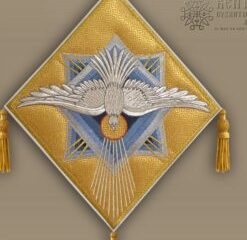Re-commit to our spiritual lives: Prayer Corner at Home
A desire for a fuller personal prayer life that includes regular daily prayers. One thing that can help keep this resolution includes having a dedicated place in our home where we can pray. A common practice for Orthodox Christians is having a prayer corner (sometimes called a “home altar”) in one’s home. If you are new to this practice (or need some motivation to re-start), I’d like to offer the same basic advice I give people in my parish.
In its most basic form, a prayer corner is a shelf with a few icons that is set aside for prayer. Some people have a small table or a specific wall in their home with several icons set aside for prayer. In a few instances, I’ve seen homes where the family sets aside an entire room as a home chapel.
While these are all options, my advice starting out is to begin with just a shelf, an icon of Christ, and an icon of the Mother of God. We can add things over time: icons of other saints and feasts, an incense burner, candles, etc. The idea is to give a physical place in your home to prayer and to start praying there regularly, not to remodel part of your home. If we start out simply, we stand a better chance of actually praying, rather than starting a “home renovation” project that will delay our efforts at prayer.
The prayer corner can be anywhere in your home, but, ideally, it should be somewhere easily accessible, quiet, and oriented eastward. First, you want the prayer corner somewhere easily accessible so that you are encouraged to actually go to it and pray. A space tucked away in a seldom-used part of our home means that we will neglect going there for prayer.
This also needs to be balanced with the idea of a quiet space, especially in family homes. In a family, the prayer corner is somewhere that the family can gather together for family prayer, but there may be times when an individual family member may want to pray alone in the prayer corner without distractions. While being readily accessible, the prayer corner needs to be in a place where there is not high traffic or noise (conversation, TV, computer, music playing, etc.).
Also, our prayer corner should mimic to some degree what we see at church. If possible, the prayer corner should be oriented on an eastward wall, just like the iconostasis and altar at church are. In a sense, we are setting up part of our home to be like the iconostasis and altar at church.
Once a space has been identified, it needs to be populated with icons. There are several good places online where you can purchase icons. Some parishes have parish book tables or bookstores that sell icons.
Once you have acquired icons, ask your priest to bless them for you. There are special prayers to bless icons using holy water. In my parish, I ask parishioners to bring me their icons before a Sunday Liturgy. I bless the icons with holy water and prayers before the beginning of the Liturgy, then place the blessed icons on the altar for the entire Liturgy. While not required, it means that the icons have been part of the Liturgy itself and in the presence of the Body and Blood of Christ. After the Liturgy, I return the now-blessed icons to the family.
In transporting blessed icons home, the traditional practice is to have the images facing inwards at one another and with both backs outward, not stacking one icon on top of another. At home, the icon of Christ should be place on the right and the icon of the Mother of God on the left, just as we see on the iconostasis at church.
With this simple start, we can easily dedicate a specific place in our home where we can say our daily prayers. The next step is even more important: actually using the space regularly for prayer.



0 Comments